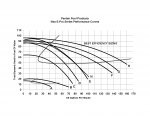I have a 21000 gal in-ground with a Sta-Rite System 3 cartridge system with 2 inch piping. I have a pool cleaner but it has a separate booster pump. I've got a flood system but only by 5 feet. No spa or fountain, just the pool (gunite). I have a SWG.
Currently I have Sta rite max e pro single speed 1.5hp pump. It has a SF of 1.47 so a SFHP of 2.2 (220v). P6E6F-207L.
I'm thinking about upgrading to a 2-speed. Sta Rite makes 2
P6RA6YG-206L - 1 1/2 HP but SFHP of only 1.65
P6RA6YG-207L- 2hp with a SFHP of 2.2
So to match my existing SFHP, I'd need to go to the 2hp it would seem. Is this right?
But the other question is whether the existing is properly sized. Right now, I keep the pump on 8 hrs during season and I'd planned on changing to 12 hrs using the low speed of the 2-speed system.
In thinking further, since I have a cartridge system and a booster pump, why do I need the higher speed of the 2 speed pump? Why not just get the lower speed as a single speed pump? Maybe I need to increase to the high speed with the pool cleaner, even with the booster pump.
Thanks for the help
Currently I have Sta rite max e pro single speed 1.5hp pump. It has a SF of 1.47 so a SFHP of 2.2 (220v). P6E6F-207L.
I'm thinking about upgrading to a 2-speed. Sta Rite makes 2
P6RA6YG-206L - 1 1/2 HP but SFHP of only 1.65
P6RA6YG-207L- 2hp with a SFHP of 2.2
So to match my existing SFHP, I'd need to go to the 2hp it would seem. Is this right?
But the other question is whether the existing is properly sized. Right now, I keep the pump on 8 hrs during season and I'd planned on changing to 12 hrs using the low speed of the 2-speed system.
In thinking further, since I have a cartridge system and a booster pump, why do I need the higher speed of the 2 speed pump? Why not just get the lower speed as a single speed pump? Maybe I need to increase to the high speed with the pool cleaner, even with the booster pump.
Thanks for the help


